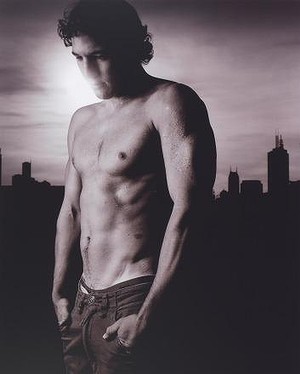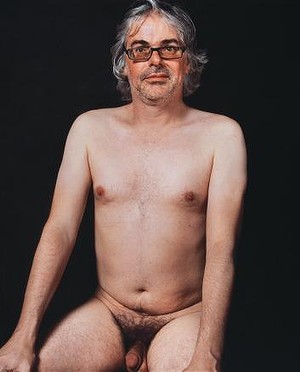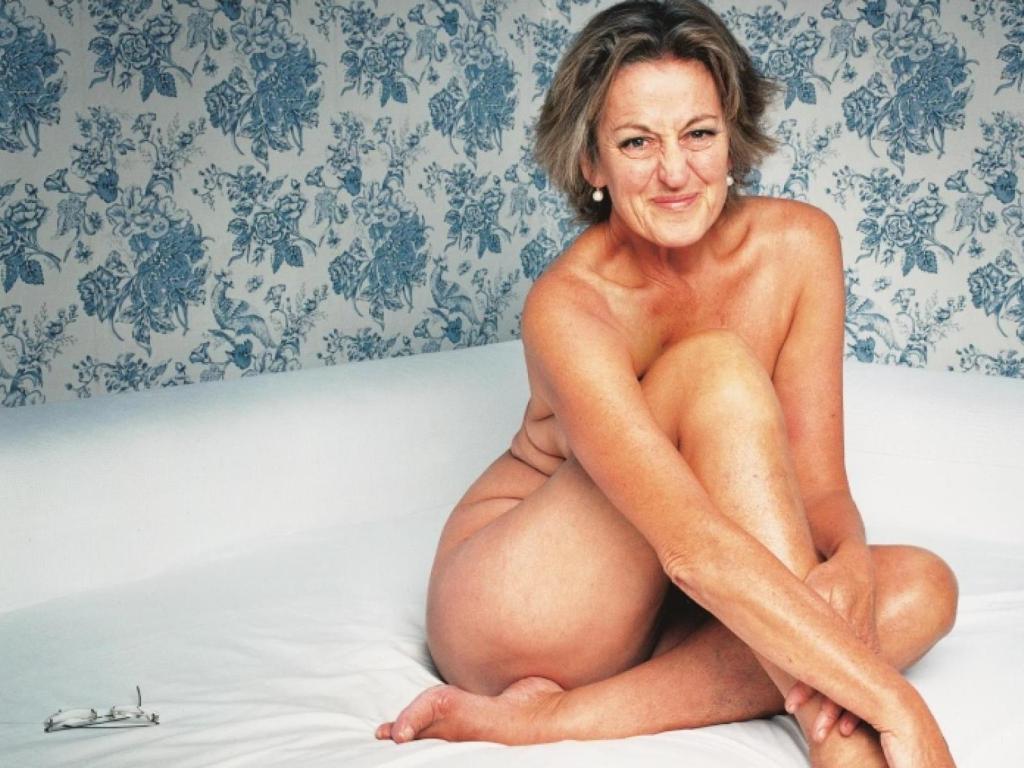This detail of portrait of Germaine Greer by Polly Borland, is the most risque it gets in NPG’s exhibition Bare: Degrees of Undress; Photo Polly Borland
While this exhibition shows a little flesh, it is hardly pushing any boundaries or offering any fresh territory in exploring the topic of nudity in Australian art.
Curator Penelope Grist has assembled 90 portraits for her investigation of nakedness in the National Portrait Gallery’s exhibition Bare: Degrees of undress, almost exclusively drawn from the gallery’s collection, bar a loaned Lucian Freud.
In fact, for such a large body of work it tells us very little about nudity and the bodily form in Australian art, and rather more about the collecting tastes and curatorial values of the NPG.
The exhibition would have benefited greatly with a few strategic loans. Australian artists have not been shy or prudish in exploring the boundaries of the topic, so the question of the deflection then lies in the reasoning behind their omission.
Furthermore, given the gallery is seated within our nation’s capital and at the backdoor of policy makers, it seemed an opportunity lost at this time when the arts is under the microscope; rather Bare: Degrees of undress has a tone of bowing to other agendas.
The media statement for the exhibition claims it: ‘celebrates the candid, contrived, natural, sexy, ironic, beautiful, and the fascinating in Australian portraiture that shows a bit of skin.’
It sounds more like a shopping list than a serious consideration of Australia’s social mores surrounding the body and nakedness in our times.
The impression is that Grist was not really interested in a show about the naked form and its social and political ramifications, but rather was focused on a ‘stripping bare’ of emotions. The exhibition’s very title, Bare: Degrees of undress, warns of its soft edge.
Where this exhibition truly reveals itself, however, is its design – or let me correct myself – over design.
Walking into the gallery audiences are bombarded with a dervish of bold text and graphics that aim to usher the viewer through a kind of discombobulated journey into themes using trigger words.
Painted bright blue and orange, these graphics at times, with total disrespect, interrupt the artworks.

Installation view of graphic exhibition design for Bare: Degrees of undress at National Portrait Gallery; Photo ArtsHub.
It also lacks respect for the intelligence of the viewer, allowing little room for their own thought, provocation or deliberation, suffocating them with over-sized ‘kiddy style’ didactics. If bare was about a psychological reveal through these works (rather than the reveal of flesh), then one needs a quietness and clarity of space to allow those considerations to surface.
We are left with the thought that they must have been thinking: ‘if we use enough visual interruption maybe visitors wont notice people are partially dressed?’ Which is, of course, counter to Grist’s statements about the exhibition.
It is a clumsiness further underlined with a Powerpoint-style projection in the end gallery that groups works from the show. I am still perplexed of its function.

Installation view of Bare: Degrees of undress at National Portrait Gallery; Photo ArtsHub.
Simply, there is nothing bare, raw or naked about the viewing experience that Grist and designer Tim Moore have created. One might conclude that Grist and her team were suffering from a case of horror vacui.
NPG director Angus Trumble has been reported as saying the exhibition ‘will appeal to everybody’ – always a worrying point for any exhibition.
He added to the Canberra Times: ‘It’s one of the most ambitious shows to be constituted completely from within the collection, the rigour of the thinking behind it is testimony to the versatility of the collection.’
So this exhibition isn’t about nudity and nakedness in Australian art, it is really about the NPGs Collection.
So what can we see in this Collection?
This exhibition rests heavily on the celebrity. It would seem that every rock star or sportsperson, or performer more generally, at some point in their career has their daring moment of partial dress or undress.
But don’t get excited by star lust. There is little laid bared in this show – literally, psychologically and curatorially.
In fact one barely sees the naked female form. Elle Macpherson and the golden girls (Olympic swimmers from the Athens Olympics), to name but two, were presented fully clothed, while the preferred female representation across the exhibition was head-shots, examples including Nicole Kidman, Hetti Perkins, Megan Gale among others.
The only female breast to be seen was in a 1890s photo of Norman Lindsay’s inner bohemian circle, and a photographic portrait of Germaine Greer by Polly Borland (pictured top) also gets close, but Greer’s nudity is concealed in a classic pose.
Men dominated this show, the favoured image being the rippling chest shot, oh and with pants on. A classic example was a pensive photographic portrait of NRL player Billy Slater by Julian Kingma.

Julian Kingma’s photographic portrait of Billy Slater featuring in Bare: Degrees of undress at the National Portrait Gallery. Photo: Julian Kingma
Others that play out that sensitive touch are Cherry Hood’s Archibald-winning painting of classical pianist Simon Tedeschi, a photograph of shirtless soccer star Harry Kewell by Robin Sellick, Polly Borland bizarre image of an armless Michael Hutchence, swimmer Ian Thorpe by James Houston (one of several of Thorpe in the exhibition), and Tracey Moffatt’s iconic image of David Gulpilil The Movie Star (1985) and another of Russell Page.
The surprise and highlight of the exhibition is a life-sized photograph by the important American photographer Andres Serrano (that in itself a boon to the show) of art collector and Founder of Hobart’s Museum of New and Old Art, David Walsh. Sadly it was lost in the ‘fluff’ that surrounds it, oddly placed next to Sellick’s portrait of Kewell – yet another image lined up backed by swirling graphics.
Cutting this show by a third would have been a good first step allowing for a more considered engagement.

David Walsh by Andres Serrano. Photo: Andres Serrano
The press material for this exhibition quotes Grist: ‘Bareness is not as extreme as nakedness and not as refined as nudity. Bareness emphasises something about a subject’s identity as well as reflecting society.’
This exhibition is a classic example of trying to squeeze an idea out of Collection, its constant pummeling of stimuli and justification serving only to further undermine it. “Bareness” is not a convincing filter for consideration. It is muddied as a term and idea, and that lack of clarity fails to deliver and exhibition with any weight or conviction.
One expects more from a national institution of this calibre.
Rating: 1 out of 5 stars
Bare: Degrees of undress
National Portrait Gallery
King Edward Terrace, Parkes. Canberra (ACT)
14 August until 15 November 2015.





